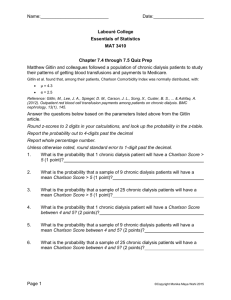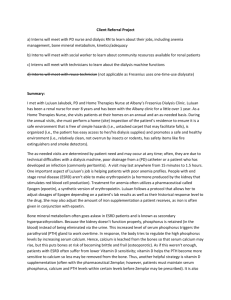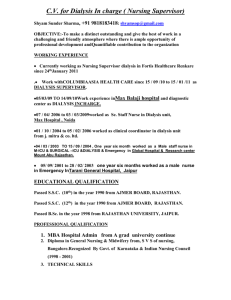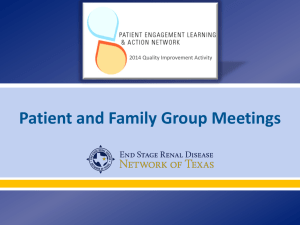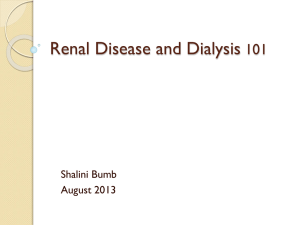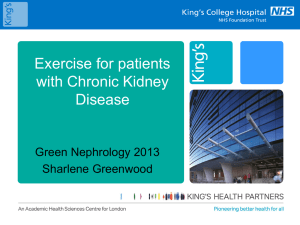Dialysis Modality Survival: Temporal Changes
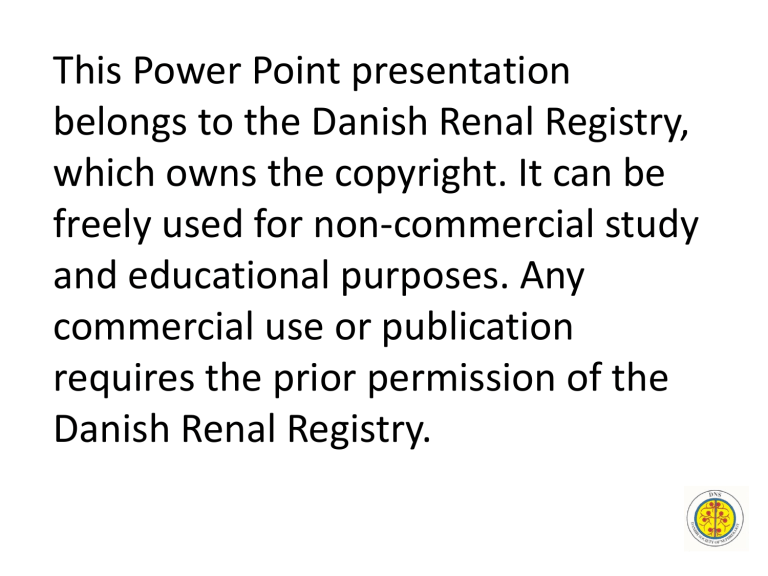
This Power Point presentation belongs to the Danish Renal Registry, which owns the copyright. It can be freely used for non-commercial study and educational purposes. Any commercial use or publication requires the prior permission of the
Danish Renal Registry.
Dialysis Modality Survival:
Temporal Changes
Heaf JG 1 , Wehberg S 2
1 Herlev Hospital, University of Copenhagen
2 Research Unit of Clinical Epidemiology, Centre for National
Clinical Databases – South, University of Southern Denmark and Odense University Hospital, Odense, Denmark
HD vs. PD: Status 2011
Introduction
• Many epidemiological studies comparing PD & HD mortality.
• Most show a survival advantage for PD during the first 1-2 years of ESRD.
• Long-term results show either equivalent results or a worse prognosis for PD.
• The practice of dialysis has changed considerably during the last 20 years. We studied changes in relative and absolute mortality over the past 20 years
Patients
• All 12,095 patients (63% male, 23% diabetic) treated with dialysis were included from the Danish Nephrology Registry database between
1.1.1990 and 31.12.2010.
• The registry is national, comprehensive and prospective.
• The Charlson comorbidity index (CCI) derived from recorded discharge diagnoses in the National Admissions Registry during the 10 years prior to ESRD.
• Major diagnoses:
– shrunken kidneys 23%
– glomerulonephritis 12%
– chronic interstitial 11%
– polycystic 7%
– hypertensive 12
– Type 1 DM 12%
– Type 2 DM 11%,
Methods
• Patients followed from first dialysis day to either death, lostto-follow-up, transplantation, i.e. an intention-to-treat (ITT) analysis.
• The effect of diagnosis, CCI, comorbidity components and cohort were investigated.
• PD and HD modalities compared using Cox proportional hazards analysis, correcting for age, sex, renal diagnosis and
CCI.
Influence of Renal Diagnosis
1990-2010
Dialysis patients only
Censored for transplant.
Age- and sex-adjusted.
95% confidence interval
Influence of Charlson Comorbidity Score
Charlson Score
Unadjusted Patient Survival (ITT)
Non-DM
DM
Increasing Comorbidity 1990-2011
Alder: 50- år
60 85 83 104 86 84 94 113 114 108 137 143 108 115 115 132 98 133 103 119 89
100.0
80.0
60.0
40.0
Alder: 60- år
82 100 73 124 108 129 130 133 130 181 168 194 182 189 185 170 170 197 170 171 138
100.0
80.0
60.0
40.0
20.0
20.0
0.0
19
90
19
92
19
94
19
96
19
98
20
00
20
02
20
04
20
06
20
08
20
10
Alder: 70- år
39 52 57 93 83 101 119 131 154 161 174 203 210 199 181 174 179 196 190 184 129
100.0
80.0
60.0
40.0
20.0
0.0
19
90
19
92
19
94
19
96
19
98
20
00
20
02
20
04
20
06
20
08
20
10
0-1 2 3-5 6+
0.0
19
90
19
92
19
94
19
96
1
19
98
20
00
20
02
20
04
20
06
20
08
20
10
Alder: 80+ år
1 5 6 8 8 12 24 39 48 64 69 63 75 68 85 125 106 101 78
100.0
80.0
60.0
40.0
20.0
0.0
19
90
19
92
19
94
19
96
19
98
20
00
20
02
20
04
20
06
20
08
20
10
0-1 2 3-5 6+
Influence of Cohort
Charlson Score
Dialysis Modality & Cohort
Significant difference from 100%: ***:p<0.001; **:p<0.01; *:p<0.05
Dialysis Modality and Age
<65 years >65 years
***:p<0.001; **:p<0.01; *:p<0.05
Dialysis Modality & Diabetes
Non-DM DM
Significant difference from 100%: ***:p<0.001; **:p<0.01; *:p<0.05
Dialysis Modality: Summary
Significant difference from 100%: ***:p<0.001; **:p<0.01; *:p<0.05
Results
• A fall in dialysis mortality was seen (HD -46%, PD -51%)
• An initial survival advantage for PD lasting up to 2 years of
ESRD was found and was common for all subgroups. PD outcomes after 4 years were poorer than HD.
• Overall, PD prognosis was better than HD, and an improvement during the 21 years was seen (relative risk 94% in 1990-94 falling to 81% in 2005-10, p<0.001).
Possible Common Causes of Improved
Prognosis
• Defined Kt/V targets
• Better Ca/P/PTH control
• Improved predialysis planning (eGFR)
• Earlier dialysis start (factitious cause)
• Elderly dialysis patients do relatively better (falling mortality risk from 1.64 to 1.51/decade).
– This is also possibly a factitious cause, since more elderly patients were included in later cohorts
• Reduced tobacco consumption
• Better cardiological treatment
• ? EPO/hypertension/ACE-I/diet ?
– No evidence of therapeutic changes during study period
Possible specific causes of improved prognosis
HD
• Biocompatible membranes
• Lower intradialytic morbidity
• ”Floating” dry weight Rx
• (No change in fistula use)
PD
• Lower peritonitis frequency
• Better fluid control
• High transport problem solved
• APD
• Icodextrin
• Less glucose Rx
• Improved catheter technology/placement
Conclusions
• The adjusted mortality of dialysis patients has improved substatially since 1990.
• The relative survival advantage of PD versus HD has improved since 2000.
• No subgroup was identified where PD had a survival disadvantage compared to HD.
• As in all epidemiological studies, caution is required in interpretation, due to the possible presence of unidentified confounders.

